check engine CHEVROLET CAMARO 1998 4.G Repair Manual
[x] Cancel search | Manufacturer: CHEVROLET, Model Year: 1998, Model line: CAMARO, Model: CHEVROLET CAMARO 1998 4.GPages: 402, PDF Size: 21.2 MB
Page 305 of 402

Downloaded from www.Manualslib.com manuals search engine When It’s Time for New Tires
One way to tell when it’s
time for
new tires is to
check the treadwear
indicators, which will
appear when your tires have
only
1/16 inch (1.6 mm) or
less of tread remaining.
You need
a new tire if any of the following statements
are true:
YOU can see the indicators at three or more places
around the tire.
You can see cord or fabric showing through the
tire’s rubber.
The tread or sidewall is cracked, cut or snagged deep
enough
to show cord or fabric.
The tire has a bump, bulge or split.
The tire has a puncture, cut or other damage that
can’t be repaired well because of the size or location
of the damage.
Buying New Tires
To find out what kind and size of tires you need, look at
the Tire-Loading Information label.
The tires installed on your vehicle when it was new had
a Tire Performance Criteria Specification (TPC Spec)
number on each tire’s sidewall. When you get new tires,
get ones with that same TPC Spec number. That way
your vehicle will continue to have tires that are designed
to give proper endurance, handling, speed rating, traction, ride and other things during normal service on
your vehicle.
If your tires have an all-season tread
design, the TPC number will be followed by an
“MS”
(for mud and snow).
If you ever replace your tires with those not having a
TPC Spec number, make sure they are the same size,
load range, speed rating and construction type (bias,
bias-belted or radial) as your original tires.
6-47
Page 314 of 402
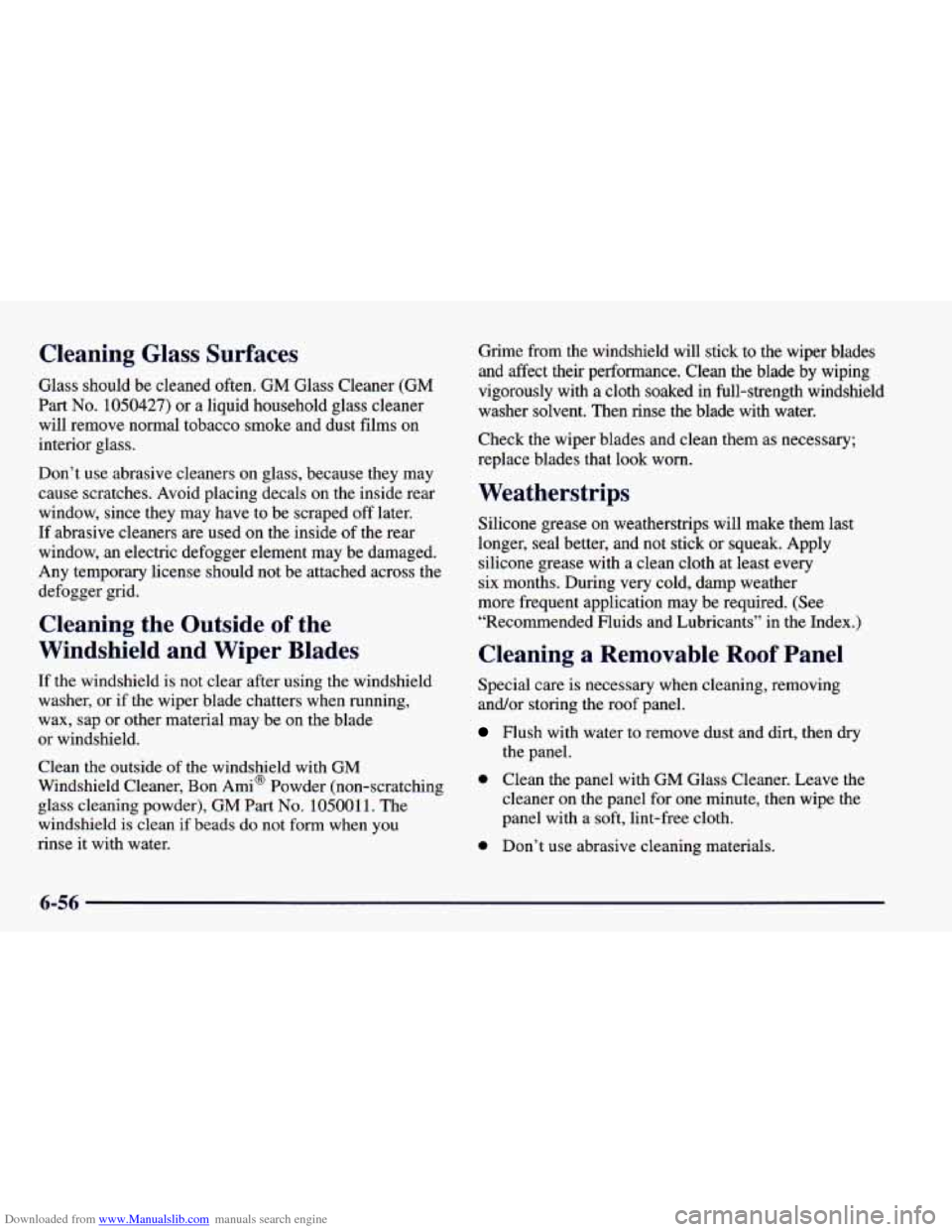
Downloaded from www.Manualslib.com manuals search engine Cleaning Glass Surfaces
Glass should be cleaned often. GM Glass Cleaner (GM
Part
No. 1050427) or a liquid household glass cleaner
will remove normal tobacco smoke and dust films on
interior glass.
Don’t use abrasive cleaners on glass, because they may
cause scratches. Avoid placing decals on the inside rear window, since they may have to be scraped off later.
If abrasive cleaners are used on the inside of the rear
window,
an electric defogger element may be damaged.
Any temporary license should not be attached across the
defogger grid.
Cleaning the Outside of the
Windshield and Wiper Blades
If the windshield is not clear after using the windshield
washer, or if the wiper blade chatters when running,
wax, sap or other material may be on the blade
or windshield.
Clean the outside
of the windshield with GM
Windshield Cleaner, Bon Ami@ Powder (non-scratching
glass cleaning powder), GM Part
No. 105001 1. The
windshield is clean if beads do not form when you
rinse it with water. Grime from the windshield will stick to the wiper blades
and affect their performance. Clean the blade by wiping
vigorously with
a cloth soaked in full-strength windshield
washer solvent. Then rinse the blade with water.
Check the wiper blades and clean them
as necessary;
replace blades that look worn.
Weatherstrips
Silicone grease on weatherstrips will make them last
longer, seal better, and not stick
or squeak. Apply
silicone grease with a clean cloth at least every
six months. During very cold, damp weather
more frequent application may be required. (See “Recommended Fluids and Lubricants” in the Index.)
Cleaning a Removable Roof Panel
Special care is necessary when cleaning, removing
and/or storing the roof panel.
Flush with water to remove dust and dirt, then dry
the panel.
0 Clean the panel with GM Glass Cleaner. Leave the
cleaner on the panel
for one minute, then wipe the
panel with a soft, lint-free cloth.
0 Don’t use abrasive cleaning materials.
6-56
Page 320 of 402
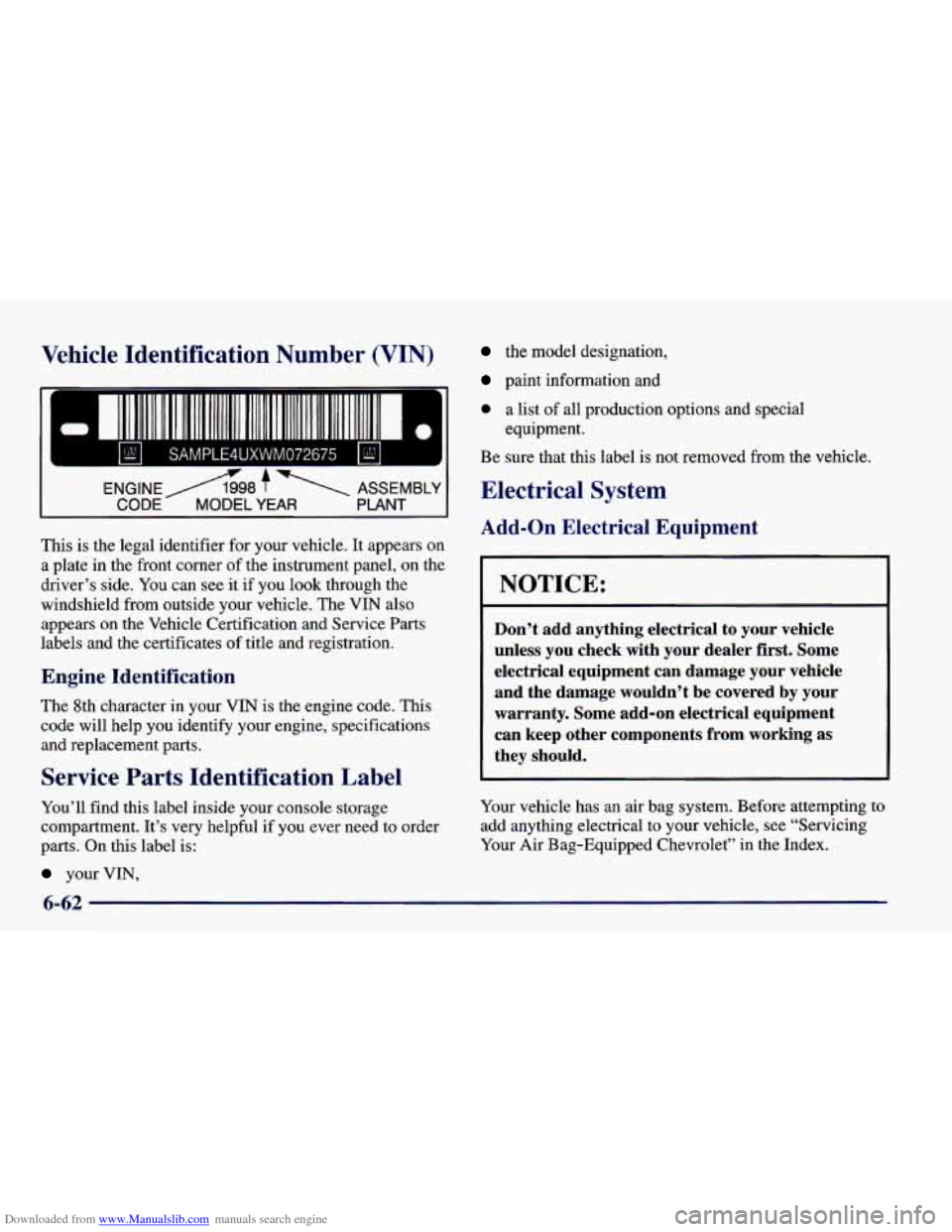
Downloaded from www.Manualslib.com manuals search engine Vehicle Identification Number (VIN)
L1
the model designation,
paint information and
0 a list of all production options and special
Be sure that this label is not removed from the vehicle.
equipment.
Electrical System
This is the
legal identifier for your vehicle. It appears on
a plate in the front corner of the instrument panel, on the
driver’s
side. You can see it if you look through the
windshield from outside your vehicle. The VIN also
appears
on the Vehicle Certification and Service Parts
labels and the certificates
of title and registration.
Engine Identification
The 8th character in your VIN is the engine code. This
code will help you identify your engine, specifications
and replacement parts.
Service Parts Identification Label
You’ll find this label inside your console storage
compartment. It’s very helpful if you ever need to order
parts. On this label is:
your VIN,
Ad(
r- NOTICE:
iquipment
Don’t add anything electrical to your vehicle
i unless you check with your dealer first. Some
electrical equipment can damage your vehicle
and the damage wouldn’t
be covered by your
warranty. Some add-on electrical equipment
can keep other components from working as
they should.
Your vehicle has an air bag system. Before attempting to
add anything electrical to your vehicle, see “Servicing
Your Air Bag-Equipped Chevrolet” in the Index.
Page 321 of 402
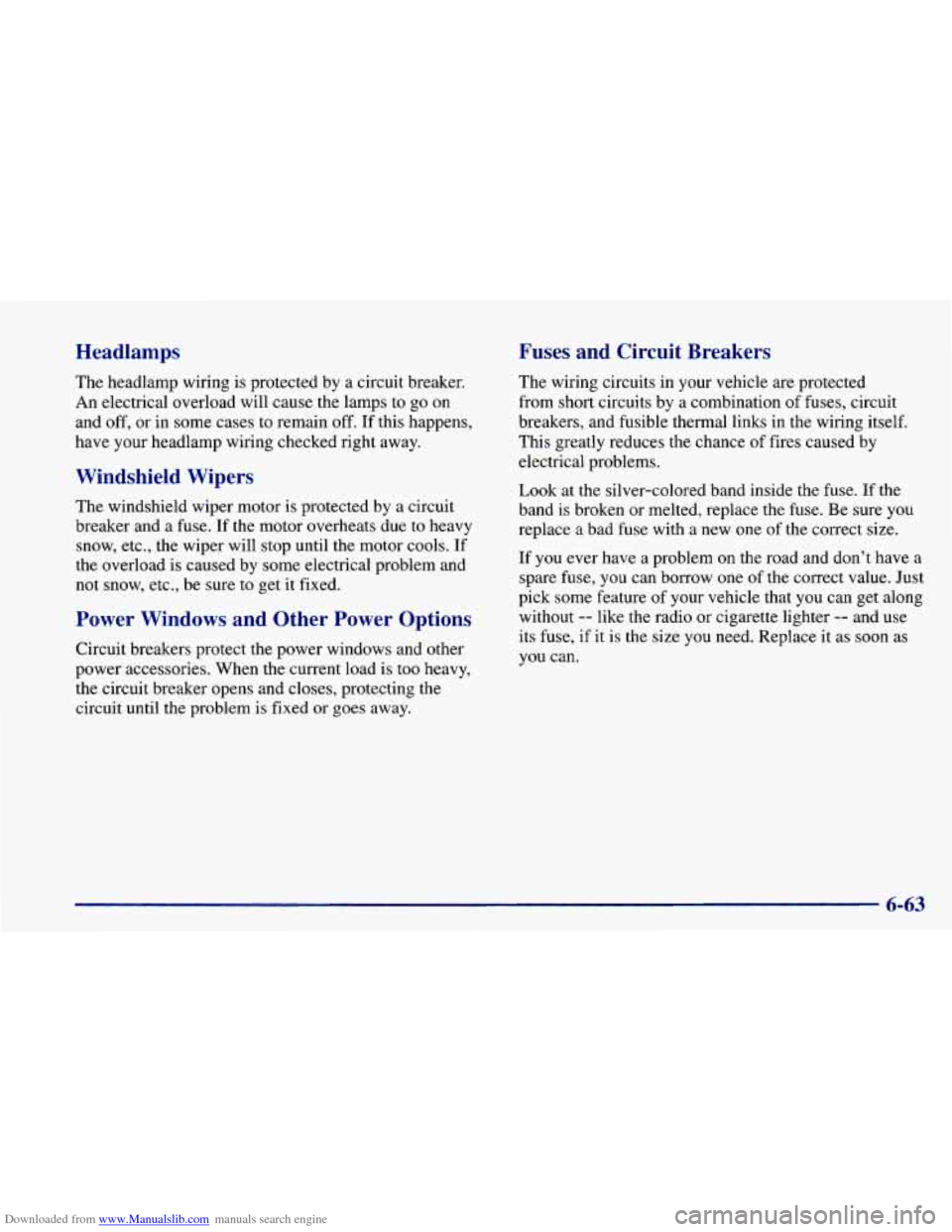
Downloaded from www.Manualslib.com manuals search engine Headlamps
The headlamp wiring is protected by a circuit breaker.
An electrical overload will cause the lamps to go on
and off, or in some cases to remain
off. If this happens,
have your headlamp wiring checked right away.
Windshield Wipers
The windshield wiper motor is protected by a circuit
breaker and a
fuse. If the motor overheats due to heavy
snow, etc., the wiper will stop until the motor cools. If
the overload is caused by some electrical problem and
not snow, etc., be sure to get it fixed.
Power Windows and Other Power Options
Circuit breakers protect the power windows and other
power accessories. When the current load is too heavy,
the circuit breaker opens and closes, protecting the
circuit until the problem
is fixed or goes away.
Fuses and Circuit Breakers
The wiring circuits in your vehicle are protected
from short circuits by a combination of fuses, circuit
breakers, and fusible thermal links in the wiring itself.
This greatly reduces the chance of fires caused by
electrical problems.
Look at the silver-colored band inside the
fuse. If the
band is broken or melted, replace the fuse. Be sure
you
replace a bad fuse with a new one of the correct size.
If you ever have a problem on
the road and don’t have a
spare fuse, you can borrow one of the correct value. Just
pick some feature of your vehicle that you can get along
without
-- like the radio or cigarette lighter -- and use
its fuse,
if it is the size you need. Replace it as soon as
you can.
6-63
Page 328 of 402
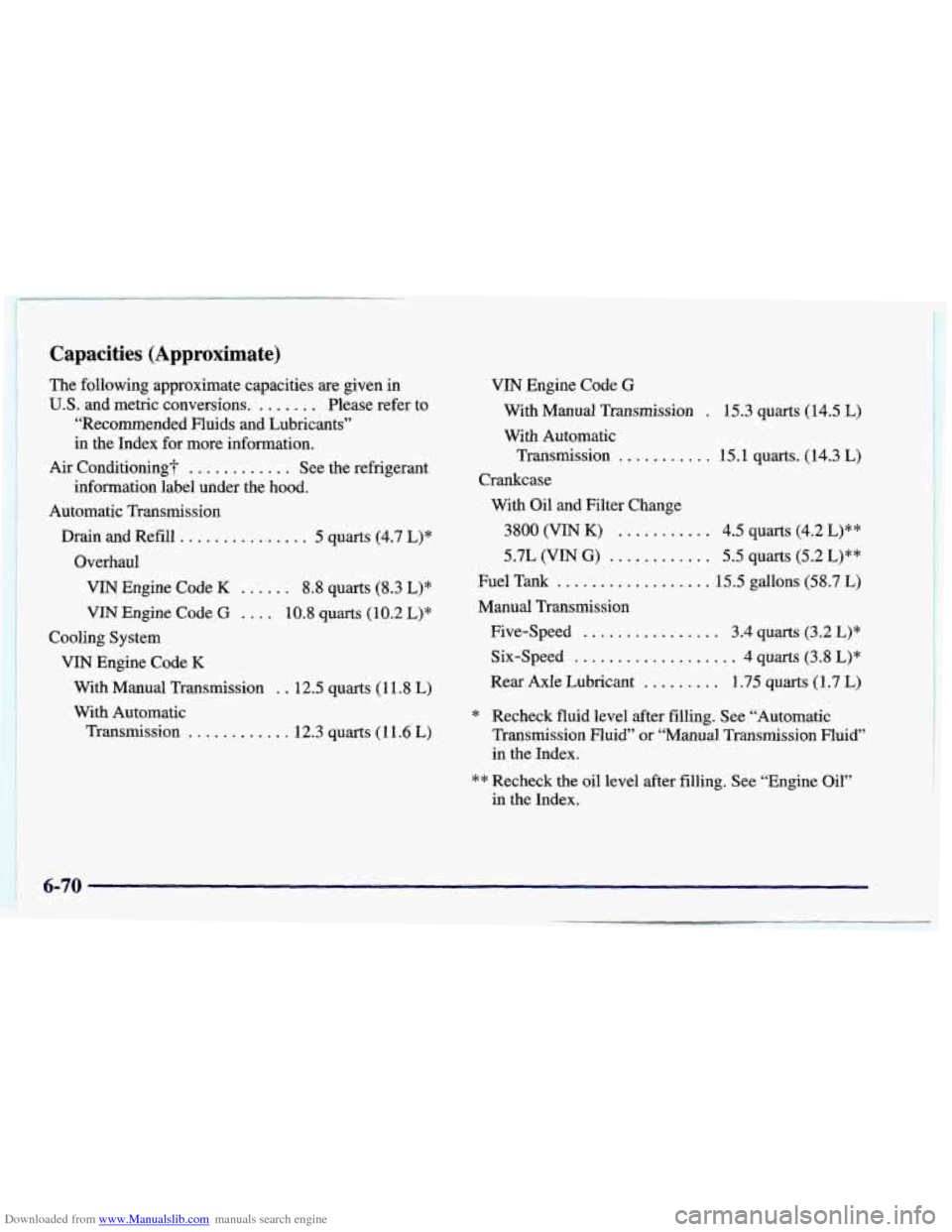
Downloaded from www.Manualslib.com manuals search engine Capacities (Approximate)
The following approximate capacities are given in
U.S. and metric conversions. ....... Please refer to
“Recommended Fluids and Lubricants”
in the Index for more information.
information label under the hood.
Air Conditioning? ............ See the refrigerant
Automatic Transmission Drain and Refill
............... 5 quarts (4.7 L)*
VIN Engine Code K ...... 8.8 quarts (8.3 L)*
Overhaul
VIN Engine Code
G .... 10.8 quarts (10.2 L)*
Cooling System VIN Engine Code
K
With Manual Transmission . . 12.5 quarts (11.8 L)
With Automatic
Transmission
............ 12.3 quarts (1 1.6 L)
VIN Engine Code G
With Manual Transmission . 15.3 quarts (14.5 L)
With Automatic Transmission
........... 15.1 quarts. (14.3 L)
Crankcase
With Oil and Filter Change
3800 (VIN K) ........... 4.5 quarts (4.2 L)**
5.7L (VIN G) ............ 5.5 quarts (5.2 L)**
Fuel Tank .................. 15.5 gallons (58.7 L)
Manual Transmission
Five-Speed
................ 3.4 quarts (3.2 L)*
Six-Speed ................... 4 quarts (3.8 L)*
Rear Axle Lubricant ......... 1.75 quarts (1.7 L)
* Recheck fluid level after filling. See “Automatic
Transmission Fluid” or “Manual Transmission Fluid”
in the Index.
** Recheck the oil level after filling. See “Engine Oil”
in the Index.
6-70
Page 331 of 402
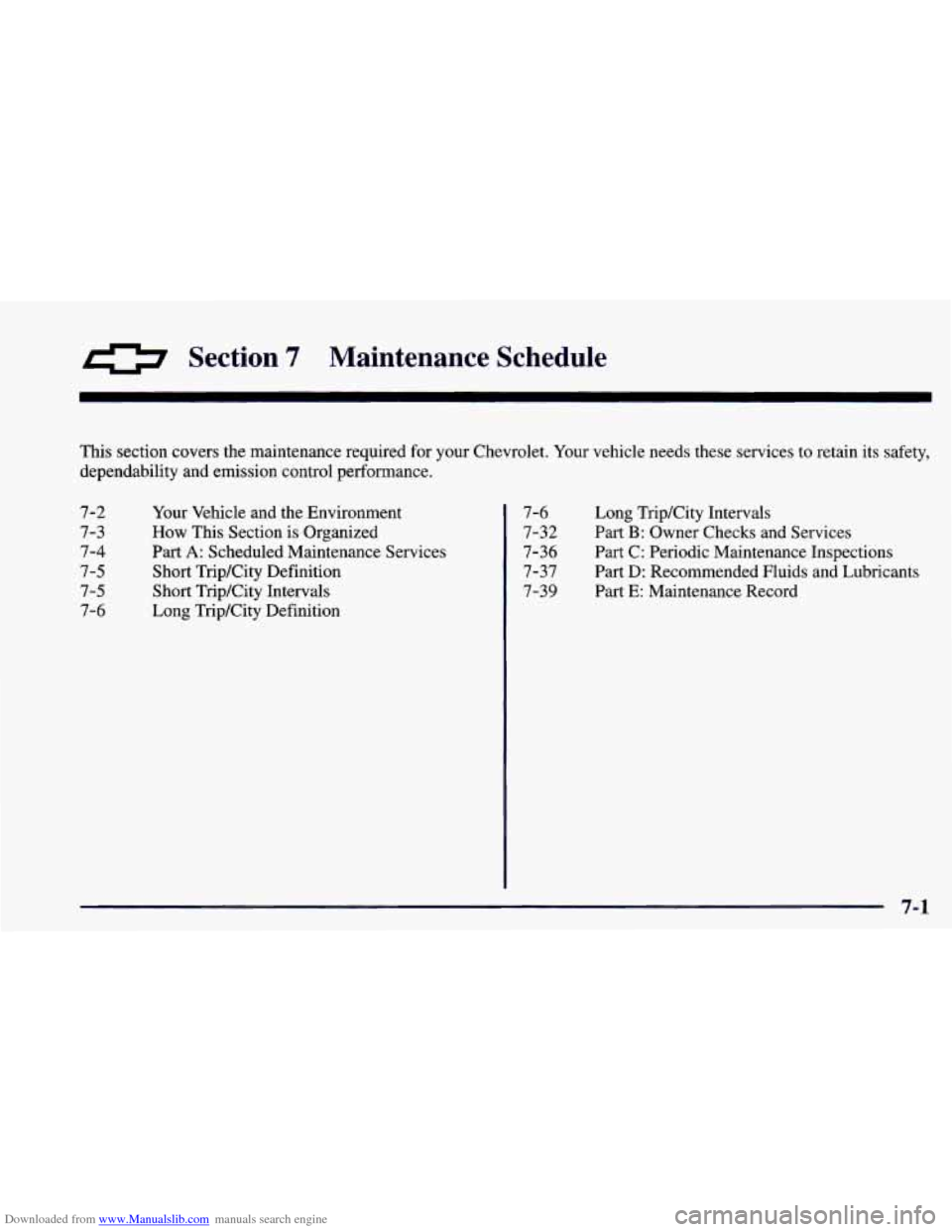
Downloaded from www.Manualslib.com manuals search engine 0 Section 7 Maintenance Schedule
This section covers the maintenance required for your Chevrolet. Your vehicle needs these services to retain its safety,
dependability and emission control performance.
7-2
7-3
7-4
7-5
7-5
7-6 Long TripKity Intervals
Part
B: Owner Checks and Services
Part C: Periodic Maintenance Inspections
Part
D: Recommended Fluids and Lubricants
Part
E: Maintenance Record
Your Vehicle
and the Environment
How This Section is Organized
Part
A: Scheduled Maintenance Services
Short TripKity Definition
Short TripKity Intervals
Long TripKity Definition
7-6
7-32
7-36
7-37
7-39
7-1
Page 333 of 402
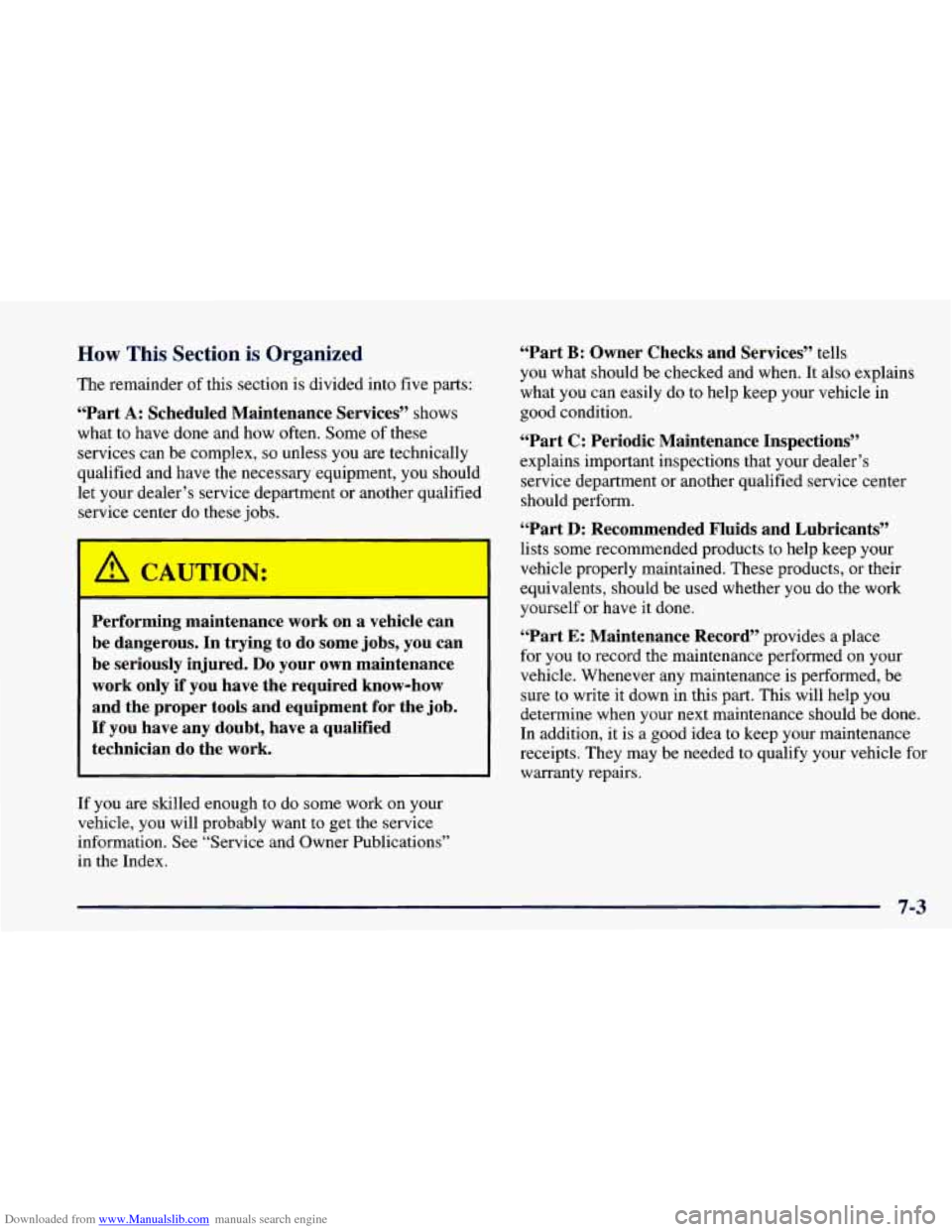
Downloaded from www.Manualslib.com manuals search engine How This Section is Organized
The remainder of this section is divided into five parts:
“Part A: Scheduled Maintenance Services” shows
what to have done and how often. Some of these
services can be complex,
so unless you are technically
qualified and have the necessary equipment,
you should
let your dealer’s service department or another qualified
service center do these jobs.
A CAUTION:
Performing maintenance work on a vehicle can
be dangerous. In trying to do some jobs, you can
be seriously injured.
Do your own maintenance
work only
if you have the required know-how
and the proper tools and equipment for the job.
If you have any doubt, have a qualified
technician do the work.
If you are skilled enough to do some work on your
vehicle, you will probably want to get the service
information. See “Service and Owner Publications”
in the Index.
“Part B: Owner Checks and Services” tells
you what should be checked and when. It also explains
what you can easily do to help keep your vehicle in
good condition.
“Part C: Periodic Maintenance Inspections”
explains important inspections that your dealer’s
service department or another qualified service center
should perform.
“Part D: Recommended Fluids and Lubricants”
lists some recommended products to help keep your
vehicle properly maintained. These products, or their
equivalents, should be used whether you do the work
yourself or have it done.
“Part E: Maintenance Record” provides a place
for you to record the maintenance performed on your
vehicle. Whenever
any maintenance is performed, be
sure to write it down in this part. This will help you
determine when your next maintenance should be done.
In addition, it is
a good idea to keep your maintenance
receipts. They may be needed to qualify your vehicle
for
warranty repairs.
- 7-3
Page 334 of 402
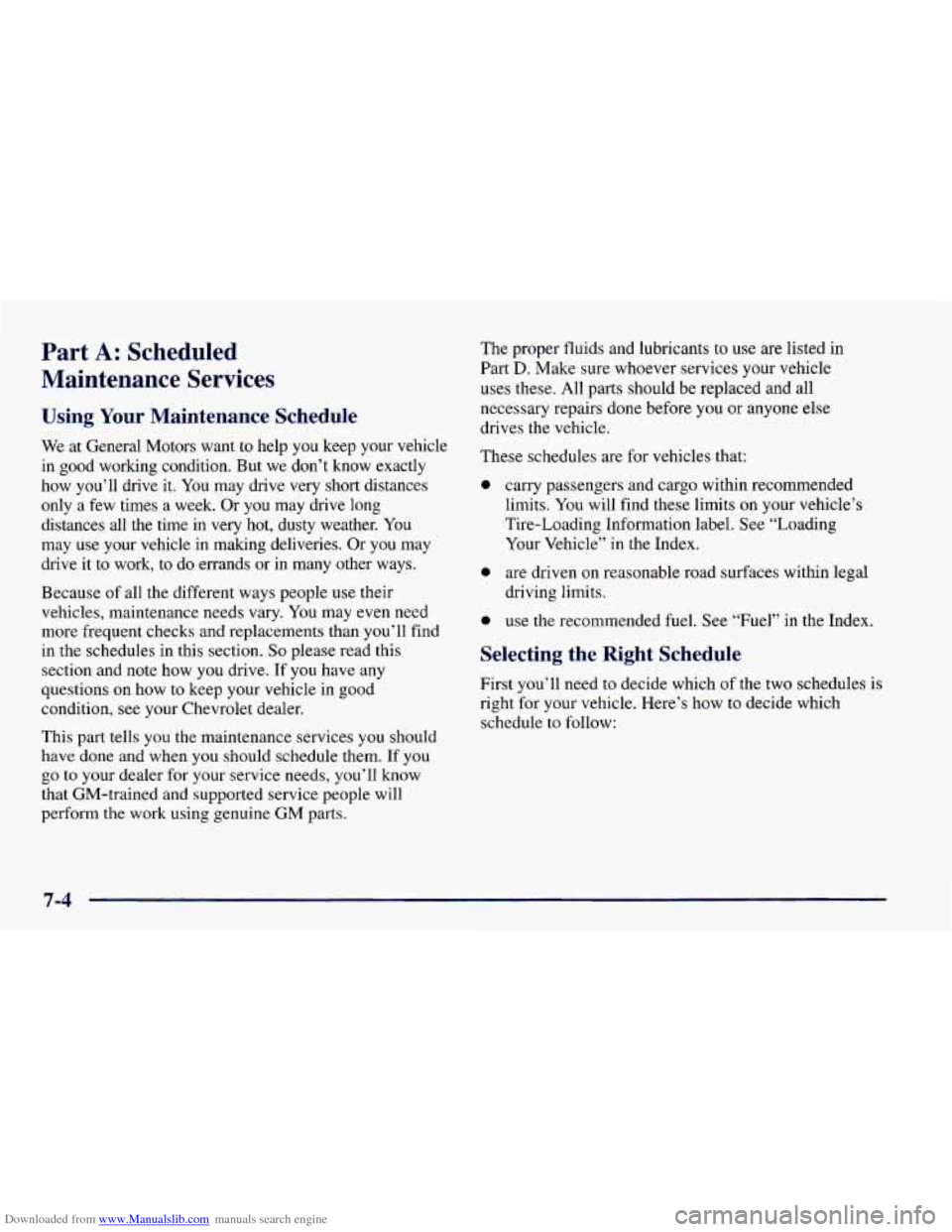
Downloaded from www.Manualslib.com manuals search engine Part A: Scheduled
Maintenance Services
Using Your Maintenance Schedule
We at General Motors want to help you keep your vehicle
in good working condition. But we don’t know exactly
how you’ll drive it. You may drive very short distances
only a few times a week. Or you may drive long
distances all the time in very hot, dusty weather. You
may use your vehicle in making deliveries. Or you may
drive it to work, to do errands or
in many other ways.
Because of all the different ways people use their
vehicles, maintenance needs vary. You may even need
more frequent checks and replacements than you’ll
find
in the schedules in this section. So please read this
section and note how you drive. If
you have any
questions on how to keep your vehicle in good
condition, see your Chevrolet dealer.
This part tells you the maintenance services you should
have done and when you should schedule them. If
you
go to your dealer for your service needs, you’ll know
that GM-trained and supported service people will
perform the work using genuine GM parts. The proper
fluids and lubricants
to use are listed in
Part
D. Make sure whoever services your vehicle
uses these. All parts should be replaced and all
necessary repairs done before you
or anyone else
drives the vehicle.
These schedules are for vehicles that:
0 carry passengers and cargo within recommended
limits. You will find these limits
on your vehicle’s
Tire-Loading Information label. See “Loading
Your Vehicle’’ in the Index.
0 are driven on reasonable road surfaces within legal
driving limits.
0 use the recommended fuel. See “Fuel” in the Index.
Selecting the Right Schedule
First you’ll need to decide which of the two schedules is
right for your vehicle. Here’s how to decide which
schedule to follow:
7-4
Page 337 of 402
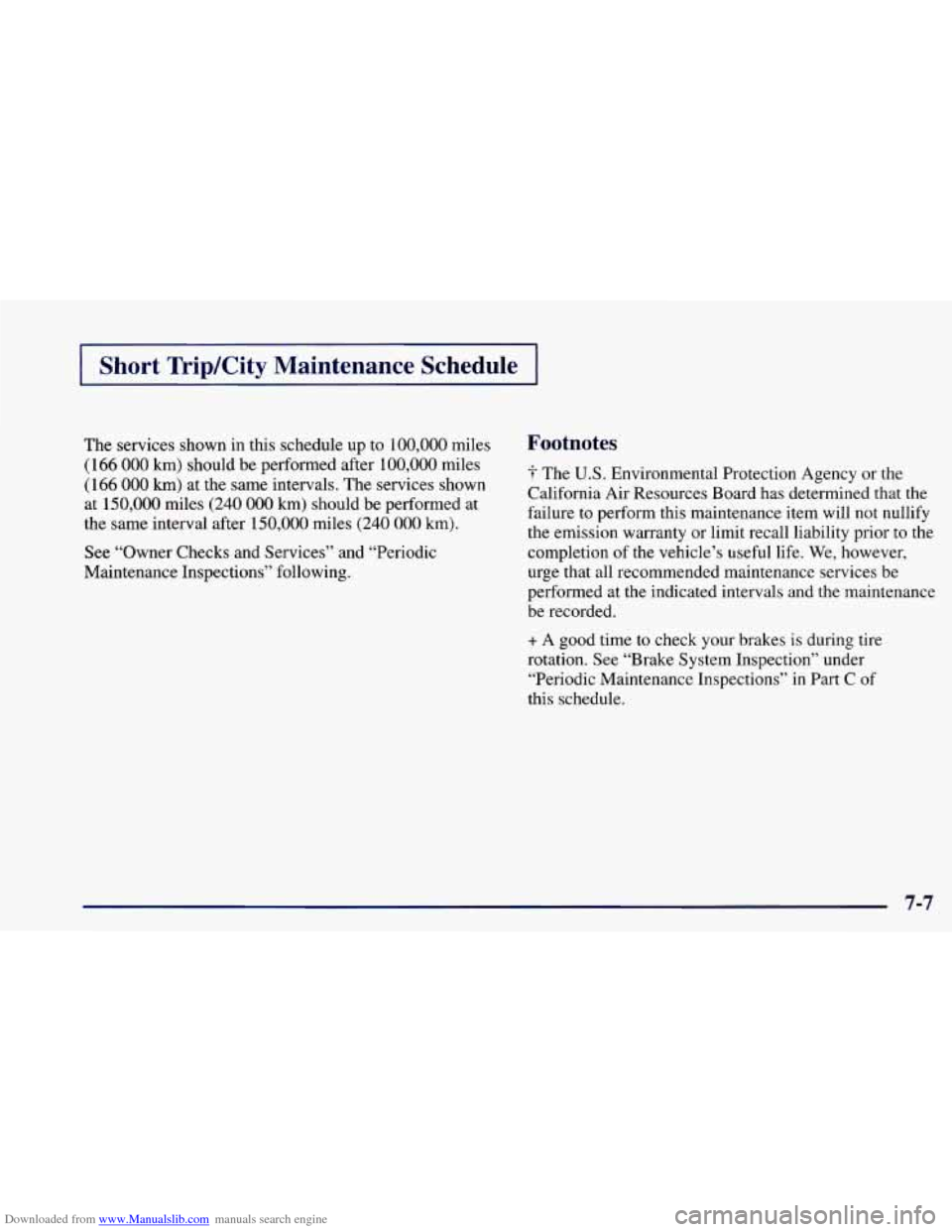
Downloaded from www.Manualslib.com manuals search engine I Short Trip/City Maintenance Schedule I
The services shown in this schedule up to 100,000 miles
(166
000 km) should be performed after 100,000 miles
(166
000 km) at the same intervals. The services shown
at 150,000 miles
(240 000 km) should be performed at
the same interval after
150,000 miles (240 000 km).
See “Owner Checks and Services” and “Periodic
Maintenance Inspections” following.
Footnotes
L t The U.S. Environmental Protection Agency or the
California Air Resources Board has determined that the
failure to perform this maintenance item will not nullify
the emission warranty or limit recall liability prior to the
completion of the vehicle’s useful life. We, however,
urge that all recommended maintenance services be
performed at the indicated intervals and the maintenance be recorded.
+ A good time to check your brakes is during tire
rotation. See “Brake System Inspection” under
“Periodic Maintenance Inspections” in Part
C of
this schedule.
7-7
Page 352 of 402
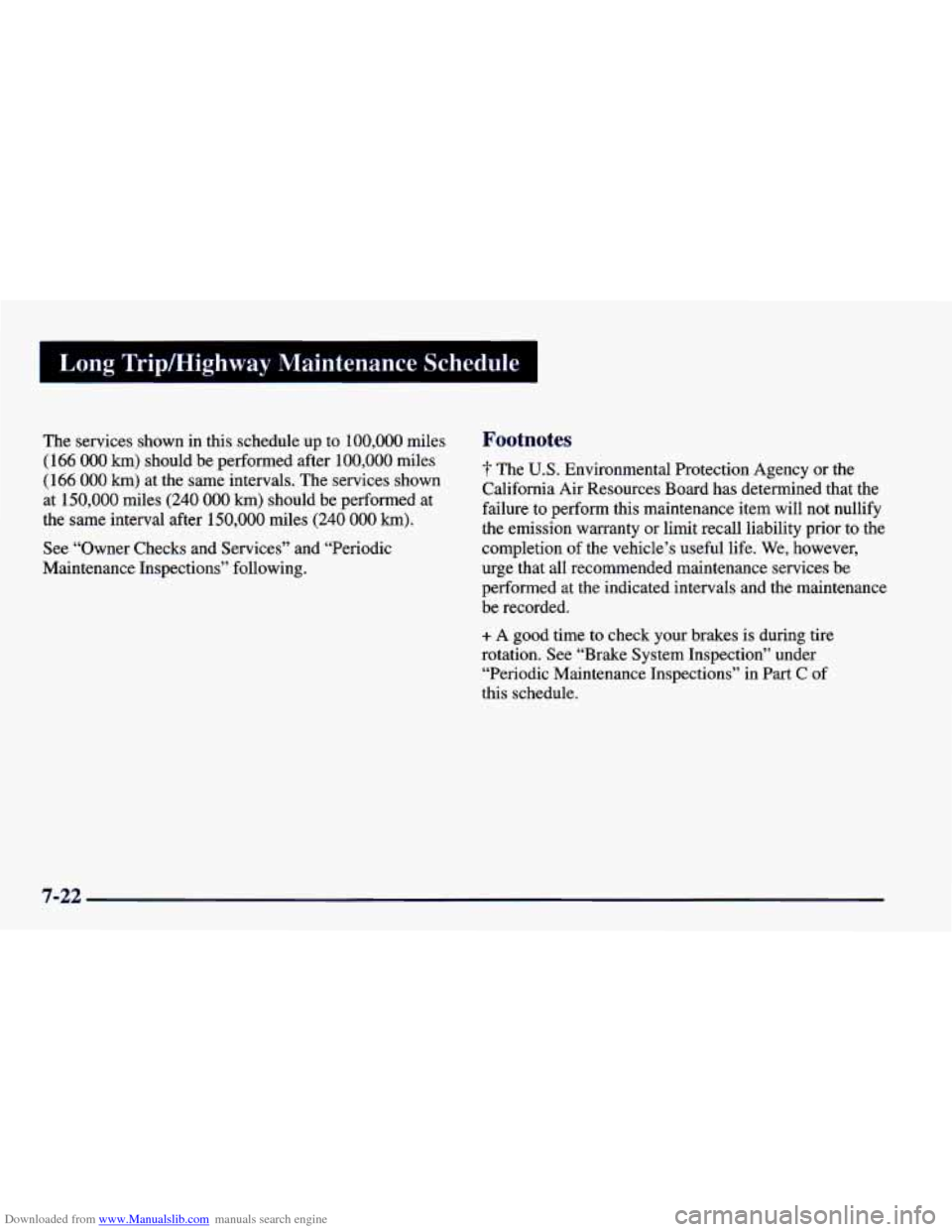
Downloaded from www.Manualslib.com manuals search engine Long Tripmighway Maintenance Schedule
The services shown in this schedule up to 100,000 miles
(166 000 lux) should be performed after 100,000 miles
(166 000 km) at the same intervals. The services shown
at
150,000 miles (240 000 km) should be performed at
the same interval after
150,000 miles (240 000 krn).
See “Owner Checks and Services” and “Periodic
Maintenance Inspections” following.
Footnotes
The U.S. Environmental Protection Agency or the
California Air Resources Board has determined that the
failure to perform this maintenance item will not nullify
the emission warranty or limit recall liability prior to the
completion
of the vehicle’s useful life. We, however,
urge that all recommended maintenance services be
performed at the indicated intervals and the maintenance
be recorded.
+ A good time to check your brakes is during tire
rotation. See “Brake System Inspection” under
“Periodic Maintenance Inspections” in
Part C of
this schedule.
7-22